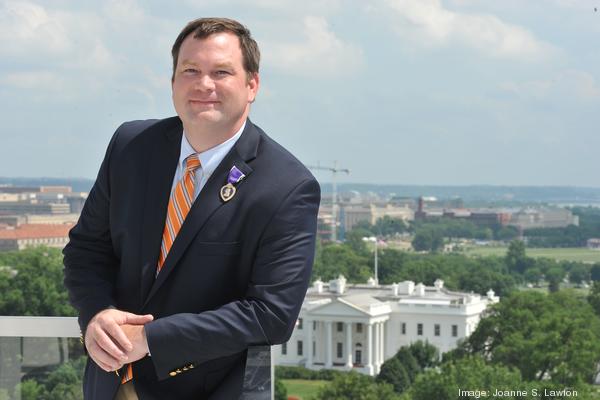 By Cynthia Washicko
By Cynthia Washicko
Mat Tully is used to tough battles. In the military, his Mideast service earned him a Bronze Star and a Purple Heart. As a lawyer, he’s won cases before the U.S. Supreme Court. Now medically retired as an Army field artillery officer after his latest tour, two-plus years in Afghanistan, he’s readjusting to the captain’s seat at the law firm he started after escaping from the World Trade Center on 9/11.
How much did your military background figure in when you started your firm? No. 1, our firm wouldn’t be where it is now if it wasn’t for the network I had in the military community. I’m a 9/11 survivor. My wife didn’t want to stay in New York immediately after 9/11, so I left my job at Morgan Stanley and moved to upstate New York and threw out a shingle and saw what came in. What was coming in were cases from my military buddies — I used to work at a federal prison. That’s how our law firm took off. The strengths of our military practice are, in great part, because of my military performance. I’ve taken very challenging military roles. I’m one of the few Army space officers that the Army has. Those roles have put a spotlight on me not pertaining to being a lawyer. Monday through Friday, I could be a great lawyer. But on the weekends, when I get deployed to war zones, I’m not an attorney. The guys on the front lines see that Mat Tully’s the guy who’s a military lawyer, who writes for the Army Times and for their legal section — here he is standing next to me on a patrol. That spreads like wildfire in the military community. When people see me in the uniform, there’s instant credibility in military circles. That’s not what you normally see on a JAG. I have the ribbons and the medals to show that I have been where these guys have been and I’ve done what they’ve done. I’m not a lawyer who sits in an office and talks about hypothetical situations. I know what it’s like.
What’s an Army space officer? The military uses space-based technology for a lot of military operations. My involvement is to assist Army leaders in knowing what’s in space and what to do to protect themselves from space-based surveillance, as well as what Americans bring from outer space to help accomplish a military mission. Pretty much anything higher than a U2 — a U2’s the highest airplane — my job is to know about it and to brief the Army side about how to protect themselves from the bad guys’ space-based assets and how to use our space-based assets to save American soldiers’ lives. I believe, at the last count, there were about 200 of us. There’s a funky-looking badge that we get. It always attracts attention because it looks like a “Star Trek” badge. It’s huge and it’s got these wings.
How did you receive some of your military honors? The Bronze Star is a high military award that you get for your service in a combat zone. I worked for the Army intelligence and security command when I was in Afghanistan and I provided services to [Army Intelligence and Security Command]. During the course of those services, I was frequently engaged in enemy contact. During the 2012 fighting season, I was the most kinetic soldier with Army intelligence, and that was the basis for the Bronze Star. “Kinetic” is a word for either being shot at or doing shooting. The Purple Heart is because a suicide attacker came by and blew up and knocked me out and collapsed the roof of my building and hurt my neck and my back. Before that, in May, I was awarded the Combat Action Badge and that’s for directly engaging the enemy with small arms fire.
What was the transition like from military service back to work? It is much more difficult than I had envisioned. The challenges that the firm is facing today are dramatically different than when I left two years ago. When I left, I 100 percent left. I did not keep tabs of the operations of the firm. I had given my law partner, Greg Rinckey, general power of attorney and gave him full authority to handle the business. So when I was out handling military stuff, I was completely out of the loop.
How is the firm different now from when you left? How we operate in almost every aspect is different than when I left. All the new faces. I have spent the last three weeks sitting down with everybody in the firm to try and get to know them and tell them a little bit about myself. It is amazing the energy and the vibe in the firm now. We’re spread out across six offices and 60 attorneys. When I left, we had three offices and about 35 attorneys. So there’s also been huge growth in our finance department, marketing department, client relations department. It is a firm that I don’t recall in almost any aspect. From the photocopier to the phones, to our VTCs, everything has changed, new software has been developed and that’s just the business side.
How about on the legal side? I specialize in handling military and federal employee law. There have been a lot of laws that have passed in the two and a half years that I’ve been away that have corrected a lot of issues. I’m trying to catch up. I’m not going to say it’s insurmountable, but there’s definitely a little bit of rust on my legal platings that I’ve got to spend some nights and weekends shining to make them perfect again.
How has that felt psychologically? That’s one of the hard parts for me. I believe when I left in 2011, beginning of 2012, I was at the top of my game running the business, being a lawyer. I was hitting grand slams, winning a case before the U.S. Supreme Court, winning a case before the highest court in New York State. Those could have been career highlights, but because of my age, I knew that those were only the beginning. So now to come back and realize there’s a learning curve again, in some aspects, I feel like a second- or third-year associate trying to figure out how to make a photocopy, let alone figure out how to outmaneuver the U.S. Department of Justice.
What are some specific changes that have been made? Luckily — or unluckily — for me, I wasn’t involved in the process changing. There has been a slew of process changing, not the least of which is the onboarding of new employees. We used to spend probably half a day for the first two days giving people our policies and teaching them the basics on employment law, and then send them on their way. Now we have a week-long training program for all new employees that I had to undergo, which was kind of funny. When I first, on day one, walked in, I introduced myself as Mat and sat in with my class and it wasn’t until about halfway through the day where somebody came in and said, “Holy cow, the boss is here,” and everybody else in the group was like, “What?”
No one recognized you? I haven’t been around, so I wasn’t involved in any of the interviewing. And I hurt my back and my neck, so I couldn’t exercise so I’ve actually gained about 40 pounds and all of the pictures in the office are of when I was in “fighting shape.” So I look a little bit different now than I did back then. Nobody put two and two together. That was fun because I was able to talk to people about their hiring experiences without them knowing that I’m the boss. It was a nice perspective. I told my wife that night, it was almost like “Undercover Boss,” just that I wasn’t dressed up.
What’s another change you’re dealing with? Another aspect is how we conduct our meetings. I used to do phone meetings and talk to people over the phone. Now we use webcams and video bridges. We have group meetings via video teleconference. We have our attorney meetings via video teleconference instead of voice or straight-up telephone conferencing.
How has your interaction with the staff changed? The number of attorneys we’ve added while I’ve been gone has been dramatic. In the past, I used to be able to reach out and grab an associate and say, “Hey Mike, or Jennifer, can you come here and help me?” Now I have to put in a formal request to get an associate to help me on a case and propose the amount of time that I’m going to need from that associate so that the workload is properly balanced across the firm. The change is consistent and never ending.
What was the most difficult part of that transition then? It’s going to sound very petty, but making a photocopy. Our photocopiers are tied to our billing software, so you have to enter your user code and then you have to enter your case code. I’m only 40 years old — I’m not 90 here — but our photocopiers have so many buttons and things to flip through to get it, it’s a little bit absurd. Everybody in the firm loves them. And I got it, they’re top of the line; I love them too. But when it takes me like three minutes of standing there figuring out what’s what, it’s a little bit hard. I’m telling you, if I could kick it, I would have. It is definitely stressing me out.
What was your most memorable moment on your first day back? Nobody knowing me, from the receptionist in the office. It was amazing. Nobody had any clue who I was. That was — I’m not going to lie — a little shock to the ego. At the end of the day, it was nice to talk to my wife about it. I often complained in the past about how I couldn’t go anywhere without bumping into somebody that I knew. It was difficult to wear shorts or sweatpants and a T-shirt because I never know who I’m going to bump into. So being able to sneak into the office and not be recognized for a few hours was pretty cool.
What was one of the biggest changes you made upon your return? There definitely were in the hiring process. When I was talking to some of my colleagues who didn’t know that I was the boss, they said that our interviewers were frequently late for their interview. We’re a service-based business, I try not to ever be late. It’s a bad impression when we’re hiring experienced attorneys to make them wait five or 10 minutes — it’s almost like being in the principal’s office. The reason behind that is sometimes interviews got very interesting and our hiring committees are back to back to back. So the standard interview was about 45 minutes, so every 45 minutes, there was another person. So if somebody ran late or if an interview got very interesting, it would run over the 45 minutes, making people late.
What did you do? I spoke to the managing teams, and we’ve created 15-minute buffers. That way, the committee’s ready for the recruit and we have a very good first impression. I know that that’s minor and petty, but in a service-based business, I say, “If we run this firm where you take out the attorney and you plug in a plumber or an electrician and it runs the same way as far as our infrastructure, we’ve done a good job.” Whether it’s an electrician providing a service or a plumber or an attorney or a doctor, the customer’s not going to come back if they don’t feel they’ve been treated properly. Some doctors made me wait an hour and a half for them. I’m sure there are legitimate reasons, but I still view that as a bad impressions and that’s not something I want to have out there. So that’s just one thing I’ve fixed in a relatively short period of time.
What do you apply from your military service to your business? In addition to the fundamental leadership skills, there’s something called the Military Decision Making Process. That is, by far, the biggest takeaway from the military that we have. All of our decisions to open new offices and their locations are all premised on the MDMP process. Our operating officers, our CFO, they’re all straight civilian so they’ve never had to deal with that before. So we actually give a class on the MDMP and show them how military commanders make decisions on where to attack, where to invade, where to land helicopters. The basic principles of the MDMP are outstanding for business applications. I wish someone would write a book converting the MDMP to civilians because I’ve spent hundreds of hours trying to and because the actual process is solid. The military wouldn’t have been using it for 100 years if it was bad. Generals use that to make life-or-death decisions. So, if it’s good enough for Gen. Petraeus to make a decision, on whether or not to increase the number of soldiers in Iraq or not, it should be good enough for any business to use to determine where should they grow their businesses.
How does MDMP work? To use it in the civilian world, its risk versus reward, but it’s done in a comprehensive, in-depth manner. It’s a process of pros and cons, risks and rewards, that bring in senior management to make the ultimate decision based off of several scenarios. Several situations are thrown out there.
Was it difficult to translate the MDMP process to a civilian business? It was hard transferring the military acronyms to civilians. But the actual process — once I was able to speak civilian — it became very easy and everybody said, “That’s great.” Our chief operating officer actually spoke at law administration association conferences on how we use the MDMP to make our decisions in the law firm.
Is there anything else you brought from the military to business? The military has provided me with some of the best management and leadership training available. I’ve gone through everything from ROTC all the way through a war college. We’re a firm that has a 400-page standard operating procedure. The military has standard operating procedures in every unit, and those SOPs are meant so that you don’t necessarily have to ask anybody for help. If you’ve read the SOP, you know how to do something. It took us a great deal of time to create our firm’s SOP and it’s rather large, but theoretically there’s nothing that somebody brand new into the firm would need to ask anybody for help on. They can just go to the PDF, type in whatever their issue is and — boom — a step-by-step guide comes up. Now, that’s not to say we’re discouraging interaction; I don’t want that to be the takeaway. But we have created what the military creates and replicated it in our firm at considerable expense. I believe that has been a huge facilitator in our growth, because when we’re hiring 25 attorneys in a year, we need to be able to train them up quickly.
What’s an example of how your military background has helped you with a case? I’m handling a military case out of Alaska dealing with a sexual assault. In military circles, there’s a huge scandal in Alaska involving their recruiting battalion and sexual assault. I have an eyewitness to some of that who’s now a client, who’s concerned they may be subjected to retaliation for whistle-blowing. I made a phone call over the Pentagon to speak with the head of one of their offices of complex investigations and the first word I said was, “Hi, this is Mat Tully I want to talk to you about a case in Alaska.” He was like, “Mat Tully from New York?” I was like, “Yeah.” He said, “Well, I’m not sure if you remember, but we served in Egypt together back in 2008.” That just got the dialogue going and we were able to go informal and he was able to provide me information and point me in the right direction that probably saved me about 10 hours worth of time. If I was just a random lawyer calling up, I would not have gotten that response. I would have probably had to serve subpoenas and spend countless dollars for my client, learning the information I was able to find out in 15 minutes. Because of those relationships, things are able to flow a little bit better.
What’s one thing you do differently now after your tours that you didn’t do in business before? I did not study the law as much in the past. My prior deployments — one was four months, the other was a year — so this one was a long time and there was a lot of change on the federal legal side. So if you weren’t up to speed, you could make a mistake. Unfortunately or fortunately for me, that has required a great deal of time and energy that, in the past, I didn’t have to expend. My departures were short-lived — coming back, it was quick getting right back up on the saddle. This time, the horse is much bigger and the saddle is much harder to get on.
What’s been key to your growth the past few years? The most important one is the success that we had early on with several big veterans’ employment cases. We made landmark cases in 2005 and 2006, which was right at the height of reservists and National Guardsmen mobilizations. We became known as the people to go to if you have [Uniformed Services Employment and Reemployment Rights Act] issues. There was nobody else in that field that had cases, and I was getting those cases because of my military connections, from when I threw the shingle out. It took a couple of years to percolate through the court system but ultimately I won numerous decisions at the U.S. Court of Appeals for the federal circuit that laid the groundwork for USERRA litigation. The publicity off of those cases, because they were egregious situations, generated more and more clients. I would say it had to do with timing, and it was luck.
How did you use that success? My law partner, Greg Rinckey, and I had to decide: Do we want to take the money and go to the Bahamas or did we want to reinvest it back into the business? At the time, we were 34, 35 years old and we decided, “Well, we want to practice law for another 30 years. It’d probably be wiser to invest that money back into the business and grow a successful law firm.” And that’s what we did.
What are you doing now to continue that growth? The first thing we’re doing is opening up an office in San Diego in September to take better advantage of a West Coast position for our practice. There’s 2 million-plus federal employees and military members — a very nice client base. Right now with our offices in New York and D.C. and Virginia, it’s difficult for people — military members and government employees — in Korea, Japan, Alaska, Hawaii, Seattle, Los Angeles, San Diego to utilize us. Opening up a San Diego office will hopefully reduce some of the time difference issues, as well as save our clients’ money. Now, if we have to go to Los Angeles, it’s an hour drive instead of a five-hour flight. If we have to go to Hawaii, we shave four to five hours off of that, same thing with Alaska.
Anything else here on the East Coast? We’re also operating a little differently in New York. We’re opening up two offices, one in Utica and one in Binghamton, so that we can cover all of New York State. Our intention is to go into New York City and be able to differentiate ourselves from every other New York City law firms, because we’re going to be the law firm that covers all of Upstate New York for legal matters. I wouldn’t say that we’re two separate law firms, but there’s clearly a D.C., Virginia business model that will align well with our San Diego office. Then our New York business model is very much aimed at helping small business owners, divorces, things of the nature that our D.C. office does not provide. They’re very distinct in their capabilities.
The basics:
- Company: Tully Rinckey PLLC
- What it does: Provides legal services to federal employees, military members and members of the intelligence community for work-related legal disputes.
- Leadership: Mathew Tully, founding partner; Greg Rinckey, managing partner
- Location: D.C. with offices in Virginia and New York
- Employees: 120
- Clients: 2,400 a year on average
- Revenue:$10 million in 2012, $13 million in 2012, $15 million in 2013
- Website: www.tullylegal.com





